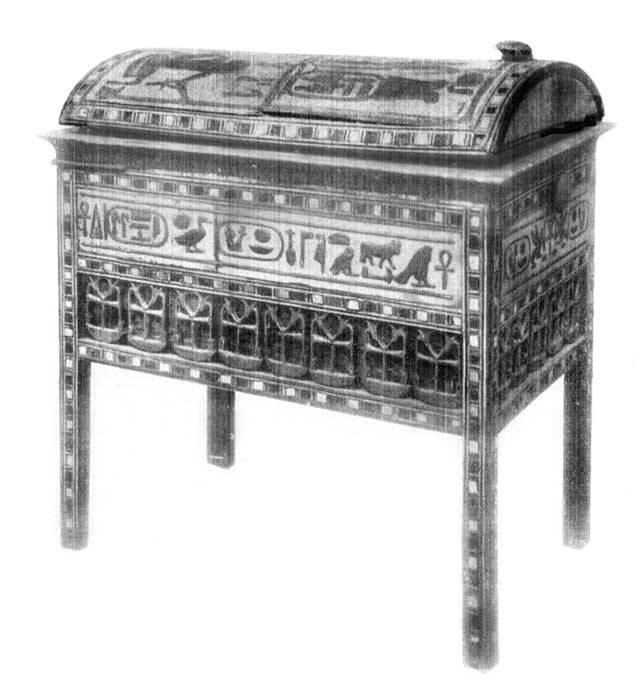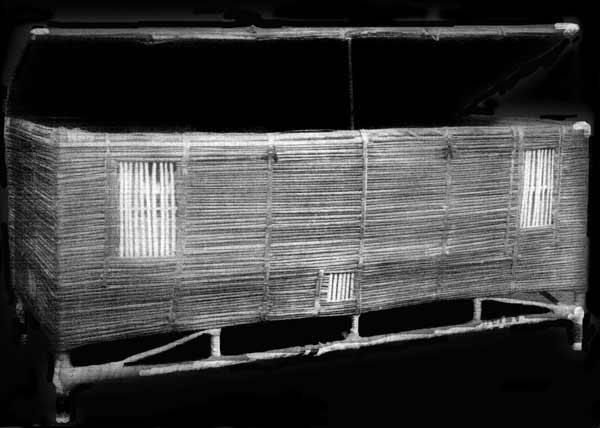.
Egyptian Museum


The Museum of Egyptian Antiquities, known commonly as the Egyptian Museum, in Cairo, Egypt, is home to an extensive collection of ancient Egyptian antiquities. It has 120,000 items, with a representative amount on display, the remainder in storerooms.

The mummy of Rameses II. of Dynasty XIX.—Cairo Museum.
Overview
The following information pertains to the state of the museum prior to the Egyptian Revolution of 2011. The museum's Royal Mummy Room, containing 27 royal mummies from Pharaonic times, was closed on the orders of President Anwar Sadat in 1981. It was reopened, with a slightly curtailed display of New Kingdom kings and queens in 1985. Today, there are about 9 mummies displayed. One of them is the newly discovered mummy of Queen Hatshepsut.

Wood and enamel jewel-case discovered in the tomb of Yuaa and Tuau. An example of the furniture of one of the best periods of ancient Egyptian art.—Cairo Museum.
History
The Egyptian Museum of Antiquities contains many important pieces of ancient Egyptian history. It houses the world’s largest collection of Pharaonic antiquities, and many treasures of King Tutankhamen. The Egyptian government established the museum, built in 1835 near the Ezbekeyah Garden. The museum soon moved to Boulaq in 1858 because the original building was getting to be too small to hold all of the artifacts. In 1855, shortly after the artifacts were moved, Archduke Maximilian of Austria was given all of the artifacts. He hired a French architect to design and construct a new museum for the antiquities. The new building was to be constructed on the bank of the Nile River in Boulaq. In 1878, after the museum has been completed for some time, it suffered some irreversible damage; a flood of the Nile River caused the antiquities to be relocated to another museum, in Giza. The artifacts remained there until 1902 when they were moved, for the last time, to the current museum in Tahrir Square. During the Egyptian Revolution of 2011, the museum was broken into, and two mummies were reportedly destroyed.[1][2] Several artifacts were also shown to have been damaged.[3]

A reed box for holding clothing, discovered in the tomb of Yuaa and Tuau.—Cairo Museum.
Interior design
There are two main floors in the museum, the ground floor and the first floor. On the ground floor there is an extensive collection of papyrus and coins used in the Ancient world. The numerous pieces of papyrus are generally small fragments, due to their decay over the past two millennia. Several languages are found on these pieces, including Greek, Latin, Arabic, and the Ancient Egyptian writing language of hieroglyphs. The coins found on this floor are made of many different metals, including gold, silver, and bronze. The coins are not only Egyptian, but also Greek, Roman, and Islamic. This has helped historians research the history of Ancient Egyptian trade. Also on the ground floor are artifacts from the New Kingdom, the time period between 1550 and 1069 BC. These artifacts are generally larger than items created in earlier centuries. Those items include statues, tables, and coffins (sarcophagi).
On the first floor there are artifacts from the final two dynasties of Ancient Egypt, including items from the tombs of the Pharaohs Thutmosis III, Thutmosis IV, Amenophis II, Hatshepsut, and the courtier Maiherpri, as well as many artifacts from the Valley of the Kings.
King Tutankhamun
Main articles: King Tutankhamun and Exhibitions of artifacts from the tomb of Tutankhamun
The Gold Mask of Tutankhamun, composed of 11 kg of solid gold, is on display at the Egyptian Museum
The Grave Mask of king Amenemope of the 21st dynasty.
Unlike many tombs discovered in Egypt, that of King Tutankhamun was found mostly intact. Inside the tomb there was a large collection of artifacts used throughout the King’s life. These artifacts ranged from a decorated chest, which was most likely used as a closet or suitcase, two ivory and gold bracelets, necklaces, and other decorative jewelry, to alabaster vases and flasks. The tomb was also home to many weapons and instruments used by the King. Although the tomb held over 3,500 artifacts, the tomb was not found completely intact. In fact, there had been at least two robberies of the tomb, perhaps soon after Tutankhamun's burial.
The best known artifact in King Tutankhamun’s tomb is the famous Gold Mask, which rested over the bandages that were wrapped around the King’s face. The mask weighs in at 11 kg (24.5 pounds) of solid gold, and is believed to represent what the King’s face really looked like.
Pharaohs
The remains of many famous Pharaohs are stored in the Egyptian Museum. One of these is Pharaoh Ramses III, who was an extremely skilled warrior. For many of the mummified pharaohs, it has been very difficult to determine when they were born, and historians can only estimate a time when they reigned over Egypt. For Amenhotep IV, historians have estimated his reign around 1372 B.C., because they found out when Amenhotep IV's father, Amenhotep III died. Also, that Amenhotep IV's tomb inscribed five names he gave himself and one of them, Golden Horus, proves that he was crowned on the bank of the Nile, his father's favorite domain. Before he became pharaoh, he was already married to Nefertiti. When Amenhotep IV did become pharaoh, he destroyed the religion of Amun. He did this because he wanted to start his own new religion of Aten, the sun, which is pictured as a disc that sends out rays ending in hands.
Historians believe Sneferu was the first king of the Fourth Dynasty. The year he started his reign was around 2620 B.C. Sneferu appears to have been a fair and just king, and seems to have deserved his chosen name of Master of Justice or Truth. Sneferu, like many other kings, built many temples and structures. All of his structures and buildings had a specific signature: the statue of a young woman symbolizing the foundation. She presents the sign of life and votive offerings, as well as the signs of the city and the stronghold. There are about four or five of these structures in each province.
Many pharaohs chose coronation names and they all seemed to be alike. For example, Sneferu, Tutankhamun and Amenhotep all had the name "Golden Horus".
See also
Egyptian Museum of Turin
Egyptian Museum of Berlin
Grand Egyptian Museum
List of museums with major collections of Egyptian antiquities
References
^ "Looters destroy mummies during Egypt protests". ABC News. 2011-01-29. Retrieved 2011-01-29.
^ "Vandals ravage Egyptian Museum, break mummies". Al-Masry Al-Youm. Retrieved 30 January 2011.
^ "Statues of Tutankhamun damaged/stolen from the Egyptian Museum". The Eloquent Peasant. Retrieved 30 January 2011.
Further reading
Brier, Bob (1999). The Murder of Tutankhamen: A True Story. ISBN 0-425-16689-9.
Montet, Pierre (1968). Lives of the Pharaohs. World Publishing Company.
Wafaa El-Saddik. The Egyptian Museum. Museum International. (Vol. 57, No.1-2, 2005).
Egyptian Treasures from the Egyptian Museum in Cairo, Francesco Tiradritti, editor, Araldo De Luca, photographer. 1999, New York: Abrams ISBN 0-8109-3276-8. Also published, with variant titles, in Italy and the UK. Reviews US ed.
Retrieved from "http://en.wikipedia.org/"
All text is available under the terms of the GNU Free Documentation License

